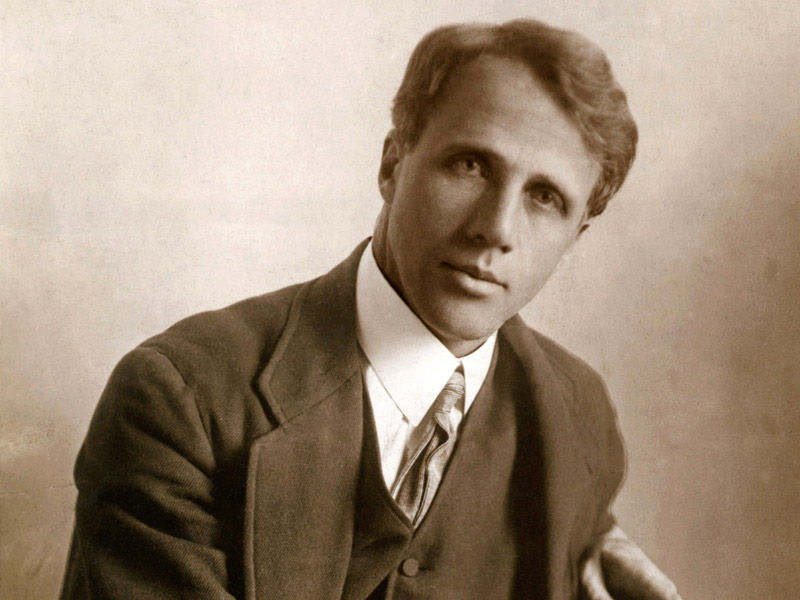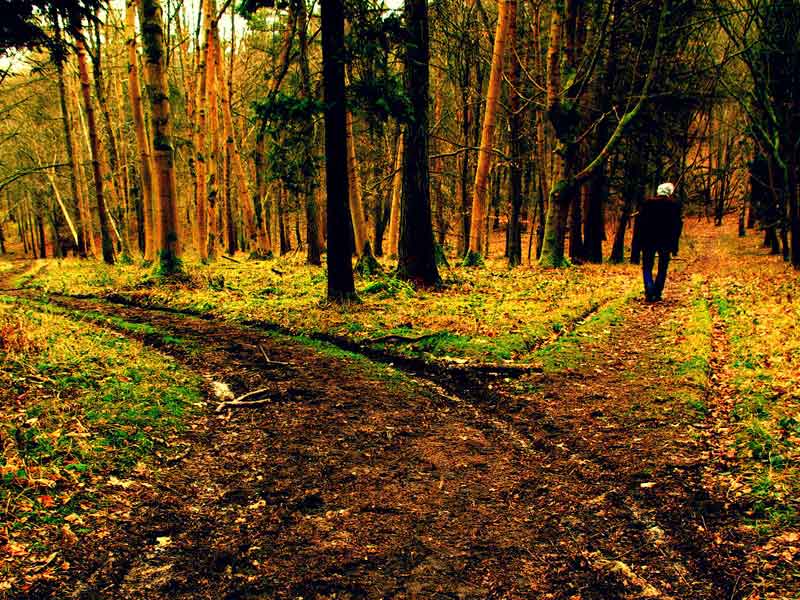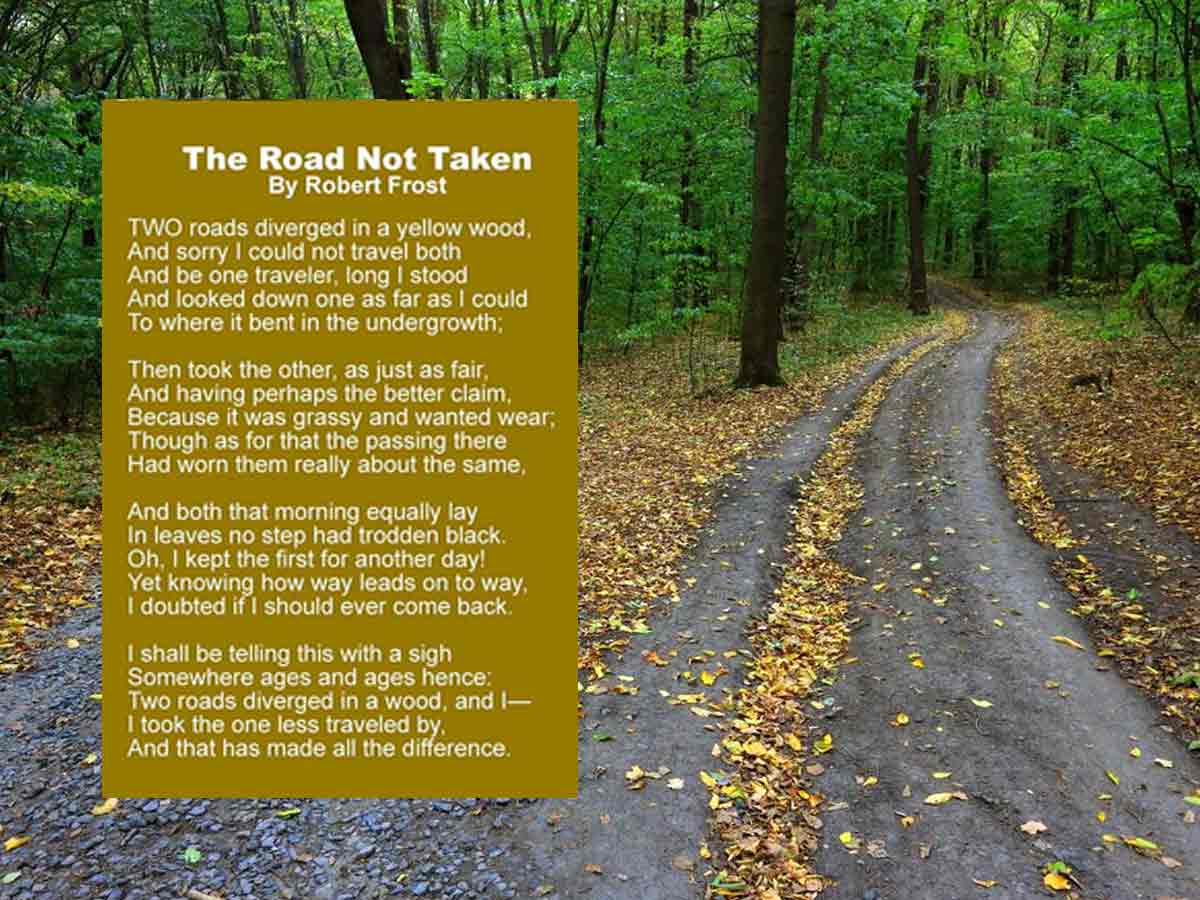Because Robert Frost is undoubtedly one of the most well-known American poets of all time, it’s no surprise that his work is taught in high schools and universities across the country. Because he’s so well-known, you’ve probably heard “The Road Not Taken” before.
We’re here to assist you in developing a greater understanding of “The Road Not Taken.”
“The Road Not Taken” is a narrative poetry, which means it recounts a tale. It was written as a joke for Frost’s buddy, Edward Thomas, in 1915. Frost and Thomas enjoyed trekking together, and Thomas frequently had difficulty deciding which path to choose.
Frost originally read it to a group of college students, who, to Frost’s astonishment, believed it was a very serious poem. “The Road Not Taken” was initially published in The Atlantic Monthly in August 1915 and was then republished as the first poem in his poetry book Mountain Interval the following year.
A Summary of Robert Frost’s The Road Not Taken

“The Road Not Taken” is an ambiguous poetry that invites the reader to consider life’s options, such as whether to follow the crowd or go it alone. If life is a trip, this poem illustrates the points at which a decision must be taken. Which path will you take?
The ambiguity stems from free choice vs determinism, and whether the speaker in the poem chooses the off-the-beaten-path route intentionally or just because he doesn’t like the road with the bend in it. As a result, other forces decide his decision for him.
Robert Frost composed this poem to emphasize and mock his buddy Edward Thomas, an English-Welsh poet who, while out walking with Frost in England, often regretted not taking a different path. Frost felt Thomas sighing over what they could have seen and done was quaintly lovely.
- Frost’s buddy regretted not pursuing the unknown route that may have provided the finest possibilities.
Frost enjoyed teasing and provoking people. “No matter whatever route you follow, you’ll always sigh and wish you’d taken another,” he warned Thomas. It’s odd, therefore, that Frost intended the poem to be lighthearted, yet it turned out to be anything but. It is taken seriously by the public.
It is the characteristic of a genuine poet to convert such ordinary facts, in this case, the size of a buddy on a rural stroll, into something far more.
“The Road Not Taken” is all about what did not happen: When presented with a critical conscious decision, this individual selected the least popular, most hard road. He traveled down one path, but he lamented not being able to take both, so he gave up one for the other.
Finally, the reader may form their own opinion on the speaker’s emotional state at the end. Was the decision to choose the less traveled path a good one? It makes “all the difference,” but Frost does not specify what that change is.
All of Robert Frost’s poetry may be found in The Collected Poems, which I use for all of my studies. It includes all of his classics and some new ones. It’s the most complete collection available right now.
Also Read, She Walks in Beauty: A Depth in Analysis
Historical Background

‘The Road Not Taken,’ by Robert Frost, portrays the poet or individual looking back and reflecting on previous decisions. According to Lawrence Thompson’s biography “Robert Frost: The Years of Triumph,” the poem was inspired by a Welsh friend named Edward Thomas. His companion, he said, was constantly sorry for his decision, regardless of the path he took.
Robert Frost, who considers himself a regional poet, has used New England as a recurring setting in his poems. In his early adolescence, he moved to New Hampshire. As a result, his published work reflects the rich culture, vivid imagery, history, and geography. Elements such as orchards, woodlands, farms, and small towns are frequently found. His narrators spend a lot of time outside, in the woods, in snowstorms, and gathering apples.
What Is “The Road Not Taken’s” Outline Theme?
The central topic of “The Road Not Taken” is that it is frequently hard to predict where a life-altering decision will lead. As a result, one should decide quickly and confidently.
It is natural to wonder what might have happened if the other path, the road not taken, had been selected. But thinking extensively about this scenario is pointless since it is impossible to determine if taking the other route would have been better or worse: all that can be said is that it would have been different.
What Is the Underlying Message of “The Road Not Traveled”?
“The Road Not Taken” throws the speaker and the reader into a bind. There are two roads dividing in an autumnal wood, probably because of the one road splitting, and there is nothing to do except select one road and continue life’s journey.
The fundamental lesson is that we are frequently confronted with options in life. When choosing a choice, one must decide. When we consider a decision as a fork in the road, it becomes apparent that we must select one or the other, but not both.
Frost did not say if the path he took was the right one in “The Road Not Taken.” Regardless, that is where he is now, and where he ends up is the outcome of his decision.
This poem is not about choosing the route less traveled, about originality, or about being one-of-a-kind. To be clear, this poem is about the route taken as well as the road not taken, not always the road less traveled. Anyone who has made a significant decision would agree that it is human nature to wonder, “What if…” had you taken the option you did not make. The major theme of “The Road Not Taken” is wondering the alternative life one may have had if they had done something differently.
The speaker chooses the other route at random and proclaims himself delighted once there, since it has more grass and few people have gone down it. He could always go back and attempt the ‘original’ path again. Is it a possibility? Perhaps not, since life has a way of making one thing lead to another until going backwards is no longer an option. But who knows what the future will bring? The speaker shows that when he gets older, he will reflect on this pivotal moment in his life. The morning he chose the path less traveled, because selecting that route transformed his way of being.
The Impact of Hindsight
The speaker starts at a point of bifurcation (a fancy way of saying “split into two branches”). As readers, we’re supposed to interpret the poem as both a literal tale about someone in the woods deciding which route to walk and a metaphor about how our life choices are like various roads in the woods.
As previously said, the poem makes it obvious that you cannot follow two courses and yet “be one traveler,” nor can you be assured that you will ever get the opportunity to test out your other alternatives. That’s because every decision you make leads to other decisions, all of which take you farther and further away from our beginning place.
However, the poem also implies that, while the choices we make are essential, how we interpret those decisions truly defines us.
Essentially, the speaker is suggesting that later in life, he will look back on that occasion and regard it as significant. However, we can only know which decisions are most important by using the power of retrospection. As the adage says, hindsight is 20/20!
Here’s what frost means: while we’re deciding in life, they may appear insignificant. But, when time passes and we’ve traveled further down our road, we can look back and see which decisions shaped us the most. And those choices aren’t always the ones we believe are most essential. The clarity and knowledge of hindsight allow us to recognize that doing something like adopting the “less traveled by” road has had a significant influence on our life.
Literary Devices used in The Road not taken
Frost employs several literary techniques in ‘The Road Not Taken.’ To begin, in the second, third, and fourth lines of the opening stanza, he used anaphora. Enjambment is another essential element in this work. It is seen in the third and fourth lines. Using this gadget, he keeps the flow across the lines and joins them inside.
Metonymy is used in the phrase “a golden wood,” which readers can locate. It refers to fall and its impact on nature. The word “undergrowth” has a symbol in its use. It represents the future’s unexplored places.
Irony may be seen in the second verse in the phrase, “And having possibly the better claim.” This gadget is described in further detail below. In addition, Frost employs alliteration in the term “desire wear.” In this line from the third stanza, “In leaves no footfall had trampled black,” there is an inversion or hyperbaton. There is also a synecdoche in the phrase. Readers will notice a rhetorical exclamation in the next line.
In the last stanza, the poet employs repetition to emphasize a certain theme. The term “years and ages,” for example, underlines the continuation of life’s path. While the recurrence of the word “I” at the end and beginning of the third and fourth lines should emphasize the speaker’s uncertainty. Anadiplosis is another term for this type of recurrence. Finally, the poem concludes with a contradiction.
Metaphor
Frost employs several analogies in this poem to convey his novel thoughts. The title of the poem, ‘The Road Not Taken,’ for example, incorporates a metaphor. The “road” is a metaphor for the decision we make in it. Moving on to the text, the “yellow wood” serves as another metaphor. The poet indirectly connects the concept of transformation to the golden wood in this line. He likens the speaker of this work to a traveler who gets hit while deciding which choice to take to continue his journey.
Similarly, another metaphor may be found in the last verse. The “least traveled by” route is a metaphor for the options that humans dislike. It refers to things that are out of the ordinary that pragmatic society does not accept. Some people, however, select such outlandish alternatives. As a result, in the speaker’s instance, he did not select the rarest option.
Irony
Un retrospect, the individual predicts insincerity in the future. Looking at his life, he knows he will be far from correct and even hypocritical.
He knows well that his future self would vehemently dispute his previous self’s decision. There is no single correct approach here. As a result, what is on the opposite road may leave an individual with residual emotions of guilt.
The poem has sarcastic overtones throughout and has suggestions of sorrow because of selecting a route with little understanding about either. Along the journey, the individual muses about the alternative route and what is irreversibly lost by choosing not to take it.

Symbolism in the Road not Taken
The infamous poem is full of simple literal symbolism. Robert Frost creates a fictitious stage for an individual on which he chooses the course of his life with irreversible effects. It’s a metaphor for those who face life-altering decisions. ‘The Road Not Taken,’ while appearing to be a straightforward poem, has proven subjective, allowing for various interpretations.
Readers must know the usage of symbols in this essay. The first quandary that arises while reading the text is the real symbolic value of the two routes. These roads do not denote two distinct routes. Frost points to two seemingly identical highways as a metaphor for the choices a person must make. He can only select one of them since it is physically impossible for him to be “one traveler” on both paths. Aside from it, readers might discover another sign in “a golden wood.”
With that, we’re left wondering how Frost knew the path he chose was the less frequented one. Frost most likely included this uncertainty on design, so that the reader would focus on the fact that he picked a route (any road, whether it was less frequented by), and that as a result, he has witnessed a shift in his life.





























